Stopping Traffic
Try these strategies for those days when you can't be on the 'X'
Try these strategies for those days when you can't be on the 'X'

Successful waterfowl hunters are masters of the art of persuasion. They know how to use all the tools at their disposal to convince wary ducks and geese to drop into the decoys. When possible, these hunters stack the odds in their favor by finding and setting up on that magical place that waterfowlers call the Xa marsh, field, timber hole, or sheltered bay where the birds really want to be.
But that isn't always an option, especially in areas where hunting pressure is intense. In these situations, hunters are faced with the task of trying to persuade passing flocks to drop altitude and give their spread a closer look. In waterfowl hunting parlance, this is known as "running traffic." A successful hunt under these conditions takes skill, experience, planning, and some specific strategies and methods. What follows is a collection of tips from three veteran waterfowlers who know how to convince ducks and geese to change their flight plans and make an unscheduled landing.
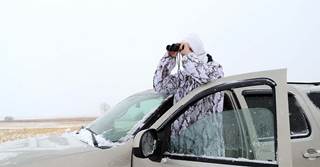
Photo Jim Thompson
Tyson Keller has spent a lifetime watching ducks and geese move between the waters of the Missouri River and the surrounding agricultural fields near his home in Pierre, South Dakota. As the birds establish patterns of movement, Keller knows that there will be days when he has access to hunt the X and days when he does not.
When running traffic is the plan, Keller zeroes in on the flight line that waterfowl will likely follow from the river to a food sourcea path that can be as long as several miles and as narrow as a quarter of a mile. To define this flight line with strict precision, he uses natural features like waterways or other landmarks to help him create a detailed plan.
"It is very important to be as close to that line as you can to get under as many birds as possible," Keller says. "Running traffic is a numbers game. You are not going to fool them all, so you need to create as many opportunities as you can. And that begins with being precisely under their flight line."
Once the flight line has been established, Keller turns his attention to finding a field.
Visibility is extremely important. So is a field that offers the same food source that the birds are using most frequently.
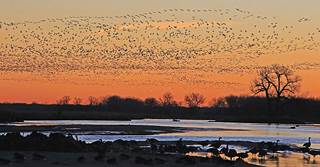
Photo DOUGSTEINKE.COM
"Sometimes I'll find the spot I want while scouting, such as when I see a flock pause along the flight line and show a little interest in a field. Maybe they slow their wing beats and lock up or actually circle the field before falling back in with the other birds in the air and keep moving," Keller says. "To me, there's maybe just enough interest in that field already that with some decoys on the ground I can turn it into a place where the birds will really want to stop."
Keller has learned the hard way to avoid the temptation of setting up too close to the place where waterfowl are actually feeding, though, because the sights and sounds of real ducks and geese on the ground make his decoys less attractive to birds flying overhead.
Keller has also discovered that it pays to monitor the weather when scouting. "When the weather is warm, the birds tend to get a little antsy, and they want to get out and stretch their wings, so you'll see them start to push out farther and farther from the roost," he says. "If this is the behavior I see on the day I'm scouting, but the weather is forecast to be cold or blustery on the day I want to hunt, I know that the birds aren't going to venture out as far, so I'll stick closer to the roost.
"And it works the other way, too. When I see a warm-up in the forecast, I can actually try to get ahead of the birds and run traffic in a field beyond the feed. The weather conditions are always going to play a role in how I position myself for the hunt."
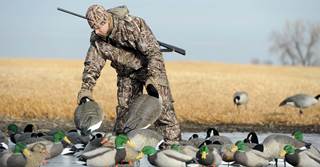
Photo Jim Thompson
Before Tony Vandemore became a guide and a part-owner of Habitat Flats in north-central Missouri, he spent his fall mornings hunting mallards on public land across the state.
"The thing about hunting those public areas was that you never knew which blind you were going to draw," Vandemore recalls. "You never knew if you were going to be hunting where the birds wanted to be. So I went into these hunts every time with the expectation that I was going to have to run traffic."
With others hunting under similar conditions and competing for the attention of the same ducks, Vandemore discovered that it was important to make his decoys stand out. "I started running Canada goose floaters in my duck spread, which I figured would work for a few reasons. First, you always see mallards landing with Canada geese, so it wouldn't be anything out of the ordinary, and the bigger decoys with their black-and-white colors would help with visibility too," Vandemore says. "But more importantly it was something different than what everybody else was doing. We got some funny looks leaving the boat launch with all those goose decoys, but we were all smiles when we came back with straps of mallards."
Vandemore uses this same approach at Habitat Flats, where the majority of the blinds are set up in locations to run traffic on mallards and other ducks trading between a roost and a food source. "We typically use three dozen Canada goose floaters and around eight dozen duck floaters in our spreads, which gives us the visibility we need to get the attention of passing flocks," he explains. "And this is a tactic that you could use on just about any body of water."
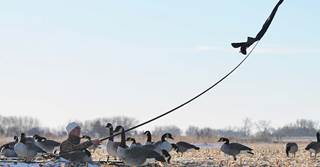
Photo Jim Thompson
Motion is the final ingredient in a decoy spread designed to stop traffic, Vandemore says, whether it's created by an ice-eater, spinning-wing decoy, jerk string, or any of the dozens of other types of motion decoys. "In a field-hunting situation for geese, a flag is your main tool to create motion in the decoys. In every situation, you use motion much like you would a call when the birds are at a distance and when you want to get a reaction."
PRO TIP: Creating motion in your spread is crucial when hunting traffic birds. Try using a flag or two to catch the attention of geese flying at a distance.
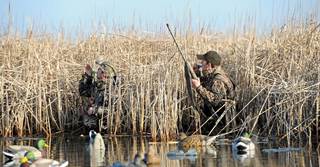
Photo Jim Thompson
From his home on Maryland's Western Shore, Paul O'Donnell learned to hunt ducks and geese the way so many other waterfowlers do: side by side with family and friends, learning from experience in the field and trying new approaches to lure mallards, black ducks, and Canada geese into range.
O'Donnell was fortunate to have access to a few farms in the region where hunting on the X was sometimes possible, but the overwhelming majority of his hunts took place on the open waters of Chesapeake Bay, in tidal creeks, or on cornfields where he managed to secure permission to hunt. O'Donnell learned to adjust his calling approach for ducks and geese in these situations.
"The overall calling method is the same. I use it to get the attention of the birds, and I use it to keep their attention," O'Donnell says. "And then I watch the reactions of the birds to tell me whether or not I need to use more or less calling until they are flaps down over the decoys."
The biggest change O'Donnell makes to his calling while running traffic is on the front end of his interaction with passing birds. He blends loud hail calls with excited double clucks for geese and uses a mix of pleading highballs and raspy quacks for mallards and black ducks.
"I'm much more aggressive with my calling than I am in a normal situation because I know that I am competing with other hunters in the area, and I'm trying to convince the birds to do something different than what they had planned," he says.
This aggressive style of calling can be amplified, quite literally, by the type of call you use. When running traffic, O'Donnell makes sure to have a short-reed goose call and a single-reed duck call, both acrylic, on his lanyard. These calls are designed to provide more volume, cut through the wind, and reach waterfowl at greater distances.
O'Donnell adds that there can be a time to tone down the excitement and switch to softer clucks for geese and content feeding chatter or simple quacks for ducks. "Some days you have to call them aggressively all the way down, but there are other days when maybe the geese aren't as vocal and the ducks are not interested in a lot of calling. On those days you can absolutely blow birds out of the decoys," O'Donnell says. "Watching their reaction is key."
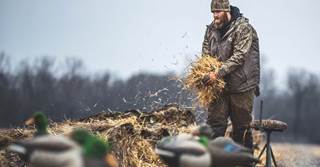
Photo Ed Wall Media
When it comes to hunting traffic birds, all three of our experts agree that concealment is crucial. "My saying is 'no hide, no hunt,'" Keller says. "And boy is that true when you are trying to convince ducks and geese to change their plans and visit your decoy spread in a field or a marsh where they weren't planning on stopping."
Keller considers the options for hiding layout blinds or an A-frame blind when selecting a field to hunt. Depressions in a field and other natural features that can be used to break up the outline of the blind are a plus, and he will even set up in areas of the field where the corn or grain stubble is taller than in the rest of the field.
Vandemore, who hunts primarily out of permanent blinds, uses natural brush to conceal "black holes" that can cause ducks and geese to flare just on the edge of shotgun range. "I'll continue to add brush throughout the course of the season, and even during a hunt, to keep things covered," Vandemore says. "Between hunters standing up to shoot or getting out of the blind, the brush can get knocked off and the blind can start to look a little exposed. It pays to take the time and keep everything covered up."
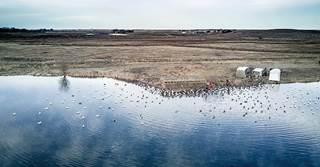
Photo Blake Fisher, RNT
In Maryland, O'Donnell conceals his blind using natural materials from the surrounding area. "I don't want my blind to stand out. I want it to blend in and appear to be a part of the field," he says. "So whether I'm using a blind along a hedgerow or standing corn or whatever it is, I always use the same kind of brush that surrounds the blind. If I can, I'll even come out the day before to get a head start gathering the brush that we need. Staying concealed is a really important piece of the puzzle."
O'Donnell adds that there may be times when the best available hide may require him to set up the blind for a crossing shot or in an otherwise outside-the-box manner. "It's OK to try something different," he says. "When you convince that first flock that your decoys are real birds and get them to stop somewhere they've never been before, it's all worth it." reaction is key."
PRO TIP: Use natural materials from the surrounding area to conceal your blind, and pay special attention to "black holes" that can spook incoming birds.
Ducks Unlimited uses cookies to enhance your browsing experience, optimize site functionality, analyze traffic, and deliver personalized advertising through third parties. By continuing to use this site, you agree to our use of cookies. View Privacy Policy